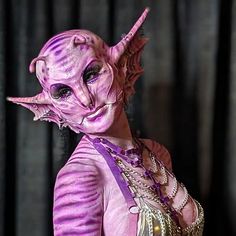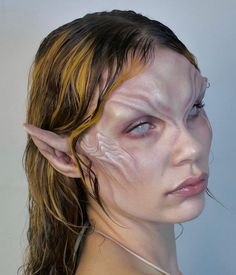Prosthetic Makeup (I)
Prosthetic makeup is a fascinating art form that involves the creation and application of prosthetic appliances to transform an individual’s appearance. From enhancing facial features to creating intricate fantasy characters, prosthetic makeup artists possess a unique skill set that combines creativity, technical expertise, and an understanding of anatomy. In this class note, we will delve into the world of prosthetic makeup, exploring its history, techniques, applications, and the creative process behind its creation.

History of Prosthetic Makeup: The roots of prosthetic makeup can be traced back to ancient civilizations, where rudimentary forms of facial prosthetics were used for theatrical performances and religious ceremonies. However, it wasn’t until the early 20th century that prosthetic makeup began to evolve into a sophisticated art form. The pioneering work of artists like Jack Pierce and John Chambers revolutionized the field, leading to the development of advanced materials and techniques.
Techniques and Materials: Prosthetic makeup involves a variety of techniques and materials to create realistic and lifelike effects. Silicone rubber and foam latex are commonly used to make prosthetic appliances due to their flexibility and durability. The process typically begins with lifecasting, where a mold of the actor’s face or body part is made to ensure a perfect fit. Sculpting is then performed to create the desired character or effect, followed by the casting of the prosthetic appliance.

Application: The application of prosthetic makeup requires precision and skill. It begins with the preparation of the actor’s skin, including cleaning and moisturizing to ensure a smooth surface. Adhesive is then applied to both the prosthetic appliance and the actor’s skin, followed by careful placement and blending to seamlessly integrate the prosthetic with the natural contours of the face or body. Makeup is then applied to further enhance the realism of the effect, including coloring, shading, and detailing.
Creative Process: The creative process behind prosthetic makeup involves collaboration between the artist, director, and actor to bring characters to life. It begins with concept development, where ideas are brainstormed and visual references are gathered to inform the design of the prosthetic appliances. Sculpting and mold making follow, allowing the artist to translate their vision into three-dimensional form. Throughout the process, experimentation and iteration are key, as adjustments may be needed to achieve the desired result.

Applications of Prosthetic Makeup: Prosthetic makeup has a wide range of applications across various industries, including film, television, theater, and special events. In film and television, prosthetic makeup is often used to transform actors into fantastical creatures, aliens, or historical figures, allowing them to inhabit roles beyond their natural appearance. In theater, prosthetic makeup can enhance characterizations and bring theatrical productions to life on stage. Additionally, prosthetic makeup is increasingly being used in theme parks, haunted attractions, and cosplay events to create immersive experiences for audiences.
Challenges and Considerations: While prosthetic makeup offers endless creative possibilities, it also presents challenges and considerations for artists. Comfort and mobility are important factors to consider, especially for actors who may need to wear prosthetic appliances for extended periods. Allergic reactions to materials and adhesives can also occur, requiring careful selection and testing of products. Furthermore, maintaining continuity between scenes and ensuring the longevity of prosthetic appliances throughout filming or performances can be challenging tasks for makeup artists.

Conclusion: In conclusion, prosthetic makeup is a dynamic and versatile art form that continues to push the boundaries of creativity and innovation. From the ancient civilizations to the modern-day entertainment industry, prosthetic makeup has played a significant role in transforming the appearance of individuals and bringing imaginative worlds to life. By understanding the history, techniques, applications, and creative process behind prosthetic makeup, we gain a deeper appreciation for the artistry and craftsmanship of makeup artists who bring characters to life on screen and stage.

